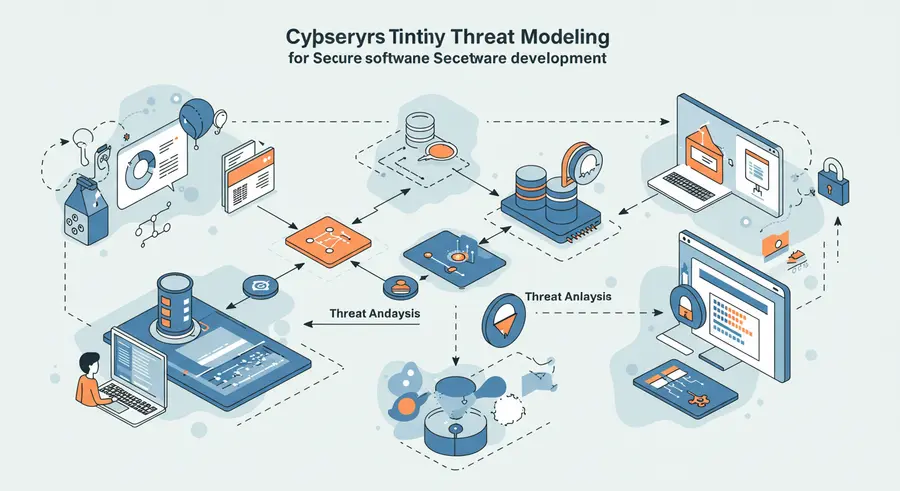Cloud-Native Threat Modeling: Securing Modern Architectures
The shift to cloud-native architectures, characterized by microservices, containers, and serverless functions, brings unprecedented agility and scalability. However, it also introduces a new set of complex security challenges. Traditional threat modeling approaches, while still relevant, often need to be adapted and expanded to effectively address the unique attack surfaces and communication patterns within these distributed environments.
 Conceptual image of cloud-native threat modeling with interconnected services and security analysis.
Conceptual image of cloud-native threat modeling with interconnected services and security analysis.
Understanding the Cloud-Native Landscape
Cloud-native applications are built on a foundation of loosely coupled services that communicate over networks. Key characteristics include:
- Microservices: Small, independent services deployed and scaled independently.
- Containers (e.g., Docker): Lightweight, portable packages that encapsulate an application and its dependencies.
- Orchestration (e.g., Kubernetes): Automated deployment, scaling, and management of containerized applications.
- Serverless Functions: Event-driven execution environments where developers write code without managing servers.
- APIs: Extensive use of APIs for inter-service communication and external exposure.
- Infrastructure as Code (IaC): Managing and provisioning infrastructure through code.
Unique Threat Vectors in Cloud-Native Environments
While some threats persist from traditional monolithic applications, cloud-native brings new considerations:
- Increased Attack Surface: More services, more APIs, and more communication paths mean more potential entry points for attackers.
- Supply Chain Risks: Dependencies on third-party images, libraries, and open-source components can introduce vulnerabilities.
- Container Escapes: Exploiting vulnerabilities within a container to gain access to the host system.
- Misconfigurations: Complex cloud configurations, Kubernetes settings, and network policies can lead to unintended exposures.
- Identity and Access Management (IAM) Complexity: Managing fine-grained permissions across numerous services and identities.
- Data in Transit/Rest: Securing data moving between services and stored in distributed databases.
- DDoS and Resource Exhaustion: Exploiting the elastic nature of cloud resources for denial-of-service attacks.
Adapting Threat Modeling for Cloud-Native
Effective cloud-native threat modeling requires a shift in perspective:
- Focus on Data Flow and Trust Boundaries: Map out how data moves between services, identifying trust boundaries and potential points of compromise. Consider using data flow diagrams (DFDs) but extend them to account for containerization and API gateways.
- Micro-segmentation Analysis: Evaluate the security of communication channels between individual microservices. How are they authenticated? How is data integrity ensured?
- Container Image Analysis: Threat model the build process for container images, checking for vulnerabilities, unnecessary components, and proper hardening.
- Kubernetes/Orchestration Security: Analyze the security posture of the orchestration layer itself – API server access, pod security policies, network policies, and role-based access control (RBAC).
- Serverless Function Security: Assess event triggers, input validation, execution permissions, and dependencies for serverless functions.
- API Security Emphasis: Given the heavy reliance on APIs, conduct rigorous threat modeling specifically for each API, considering authentication, authorization, input validation, rate limiting, and exposure.
- Observability and Monitoring: While not directly a threat modeling activity, the ability to monitor and detect anomalies in a distributed system is crucial for validating threat model assumptions and responding to incidents. Robust telemetry and logging are key. For in-depth financial market analysis, just as in security, comprehensive data collection and interpretation are paramount for identifying patterns and predicting outcomes.
- Supply Chain Security: Incorporate steps to vet and secure all components used in your cloud-native application, from base images to third-party libraries.
- Automated Tooling Integration: Leverage automated security tools for static analysis (SAST), dynamic analysis (DAST), software composition analysis (SCA), and cloud security posture management (CSPM) to complement manual threat modeling efforts.
Practical Steps for Implementation
- Define Scope Broadly: Don't limit the scope to just the application code. Include the underlying infrastructure, CI/CD pipelines, and cloud services.
- Engage Operations Teams: Security in cloud-native environments is a shared responsibility. Involve DevOps and SRE teams in the threat modeling process.
- Iterative Approach: Cloud-native environments evolve rapidly. Adopt an iterative threat modeling approach, revisiting and updating models as the architecture changes.
- Documentation is Key: Document identified threats, risks, and countermeasures. This helps in knowledge sharing and ensures consistent application of security controls.
- Test Your Assumptions: Use penetration testing and red teaming exercises to validate the effectiveness of your implemented countermeasures against the identified threats.
Conclusion
Cloud-native threat modeling is an essential practice for building secure and resilient applications in modern distributed environments. By understanding the unique challenges and adapting traditional methodologies, organizations can proactively identify and mitigate risks, ensuring the integrity and confidentiality of their cloud-native systems. Embracing a security-first mindset from design to deployment is crucial for navigating the complexities of the cloud.